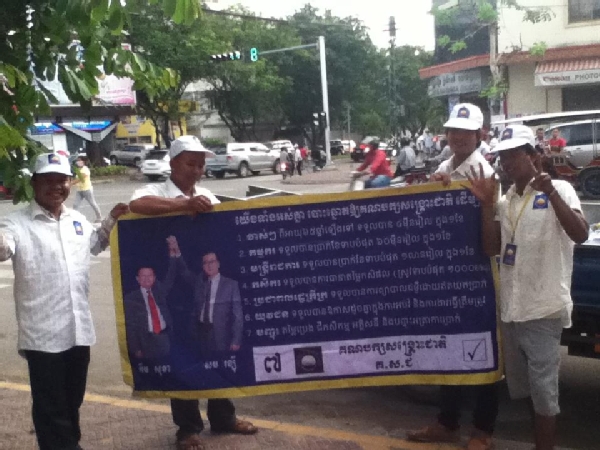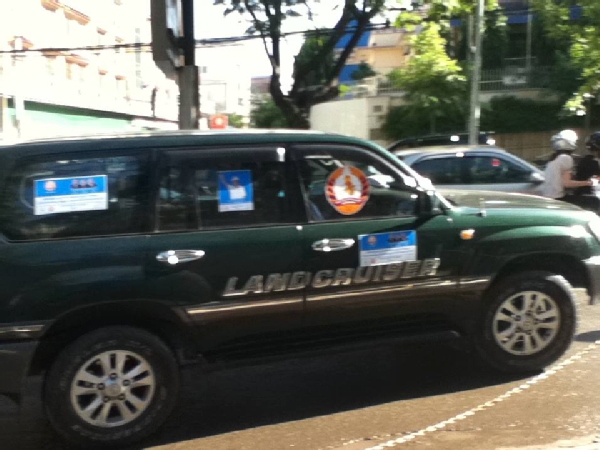Campaigning: Phnom Penh Style!


Videos of various CNRP rallies in Phnom Penh can be seen here!
The upcoming 2013 General Election would prove to be unique in many ways. While researching Cambodian Election Law and drafting the briefing, I wanted to get a better understanding of the socio-political context of this particular election. What did the political parties contesting this election stand for? Likewise, what were some of the issues that voters cared about the most?
Town Hall Debates
Thus I had the privilege of attending a “town hall debate” in Phnom Penh with Pinkie, the first of nine organized by the National Democratic Institute. Although the ruling Cambodian Peoples Party (CPP) declined to participate, both the royalist FUNCINPEC party and the newly formed opposition Cambodian National Rescure Party (CNRP) sent representatives to present their party platforms while fielding questions from the audience. Citizens asked a variety of questions on issues ranging from the process of granting of economic land concessions and the continuing deforestation of areas like Prey Lang to how to optimize economic development in order to bridge the growing wealth divide. Voters also asked many probing questions of the candidates, including how they intended to actually fund many of the provisions and programs called for in their party platforms (often accompanied by appreciative laughter from the audience). Suffice it to say the “town hall” style debate was a remarkable exercise of democracy and civic engagement.
Mobile Moto-Rallies!
Now for the actual street campaigning, this must be said: Nobody quite does election campaigning like Phnom Penh. For one, in accordance with Cambodian election law the campaigning period can only last 30 days and must end 24 hours before Election Day. No never-ending campaigning cycles, party caucuses, media circuses, or a multi-billion dollar electioneering industry. I have always believed that we as a nation can learn something from virtually every member of the international community. Not that it will likely ever happen given our Laissez-faire socio-cultural and political attitudes, but perhaps this is a practice which our political system should consider emulating.
When the campaigning period finally rolled around, the parties truly hit the ground running. Phnom Penh would witness rallies on a daily basis-mostly by the CPP and CNRP but with more low-key participation by the other parties as well. Although there were some huge stationary rallies, the favored modus operandi by all parties appeared to be mobile rallies. Long convoys of motos, along with the occasional truck, car, or tuk-tuk equipped with an array of loudspeakers, cris-crossed the main boulevards and streets of Phnom Penh on a nearly daily basis.
CPP: Organized for Victory
By far the most prevalent rallies were by supporters of the ruling CPP and the main opposition CNRP parties. The CPP rallies were impressive in that they were elaborate and highly organized. Supporters expressed their love for their party through synchronized chants and songs. CPP loyalists donned white Polo shirts and hats emblazoned with the CPP logo, as if fashion were just another weapon in their electioneering arsenal. In addition to these stationary rallies, black SUVs- emblazoned with CPP logos and posters-zipping across Phnom Penh became a common sight. While the CPP certainly had their zealous youth and student wings, the majority of CPP supporters at these rallies appeared to be middle aged men.
If I had to summarize the CPP's core campaign message, it seemed to be this: We liberated this nation from the genocidal Khmer Rogue, and then rebuilt a shattered country and society. We have laid the foundation for a thriving economy which has reclaimed Cambodia's spot as "the pearl of Asia" and "The Kingdom of Wonder." The CPP is the party of the common people, and we deserve to remain in power based on the merits of our accomplishments.
CNRP: Stealing the Fun from FUNCINPEC
I know this is an entirely subjective assertion, but the CNRP’s rallies just seemed more vibrant than those of their CPP rivals. CNRP supporters did not seem to have any coordinated uniforms, but rather wore CNRP hats while passionately waving their party’s flags as well as an assortment of banners from their motos. A common way to show your love for the CNRP was to flash seven fingers up to represent the position of the CNRP on the election ballot (versus #4 for the CPP). CNRP supporters also wore a variety of elaborate costumes, with the superhero motif (to portray the CNRP as “rescuing” the country , you know since the R in CNRP stands for rescue) a common sight. The more organic nature of the CNRP rallies really made them a much more captivating-and to be honest, fun!-affair to witness.
CNRP: Rallying for Change
From my observations in Phnom Penh, it appeared that the CNRP rallies were generally much better attended. Indeed, historically opposition parties were stronger in the cities while the CPP dominated the Cambodian countryside (where almost 80% of Cambodia's population lives). While this year the race in the countryside would be a lot closer, the cities seemed to be even stronger opposition strongholds. The CNRP were already running a vibrant and energetic campaign in Phnom Penh, and the return of Sam Rainsy after four years of exile absolutely electrified the CNRP’s supporters. In a country where an estimated 70% of the population is under 30, youth participation in campaigning was not surprising. The overwhelming presence, however, of students and other members of the youth in CNRP rallies was quite remarkable. It seemed clear to me that utilizing the passions and energy of the nation's youth was a central tenet of the CNRP's campaign.
The CNRP's message seemed to be this: The CPP in its various forms have been in power since 1981, and the current Prime Minister Hun Sen has been one of the longest serving Prime Ministers in the world. Yes there has been economic growth, but there is no long-term plan for the management of natural resources and land concessions. There has been rampant corruption and a huge income gap between the rich and poor, with the politically unconnected masses falling behind the political and business elite. The status quo is neither just nor sustanable, and a vote for the CNRP represents a vote for change.
A Darker Side
Finally, despite the largely peaceful nature and jovial atmosphere of the campaigning period, there existed some serious undercurrents of violence. The CPP has not only likened an opposition victory to a return to Khmer Rogue rule, but has repeatedly "warned" of a return to civil war should the people “fail to elect the proper party.” Cambodian voters no doubt remember the tumultuous aftermath of the 1993 elections in which the CPP lost to the opposition FUNCINPEC party but, rather than cede power, launched a violent coup and crackdown against protesters in 1997 which led to hundreds of deaths and disappearances. Given that the CPP has largely consolidated its control of the police and military (as well as most of the civil service) since 1997, it is safe to consider these "warnings" as not hollow rhetoric but naked threats, but to further view such threats as substantive options in the event that the CPP state-machinery once again finds itself without a democratic mandate-that is, if they do not simply rig the elections first.
Not to be completely outdone on the intimidation front, the CNRP has also hinted at the possibility of post-election upheaval in the event of irregularities. Given the CPP's monopoly on state instruments of violence, this will most likely translate into street actions such as strikes and protests by the CNRP rather than armed confrontation. Nevertheless, such declarations hardly contribute towards creating a peaceful and intimidation-free election atmosphere. Even more disconcerting is the fact the CNRP has repeatedly utilized anti-Vietnamese rhetoric in its campaign in order to capitalize on long-festing, Khmer Rogue-era anti-Vietnamese sentiment. Indeed in a nation with such a traumatic experience regarding the historical treatment of its ethnic minorities, this resurgence of xenophobia is a highly alarming phenomenon. One would expect better from a party which champions itself as a party of progress and change, and I can only hope that CNRP leaders will temper such vitrol in order to diffuse such a potentially volatile stituation.
Status Quo, or Hope and Change?
So what to make of all of this? I once again turn to my good friend Vicheth who I believe summarized this election best:
I think since 1993, this is the first time that the national election presents two clear choices for voters: the ruling party or the opposition. From an emotional point of view, I would say this is probably the most exciting election ever. As such, the turnout ought to increase as voters will be compelled to go to vote to keep the status quo-out of fear of civil war or instability-or to change it out of hope. Sadly, once again, I think fear will dominate hope.
Which vision of Cambodia would prevail? What would be this election’s legacy and aftermath? The nation and the world would have to wait until Election Day and the days following to find out.
Disclaimer: All views articulated in this article are entirely the writer's own and are in no way reflective of any other individuals, institutions or organizations.